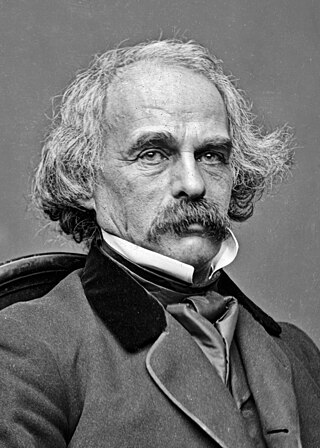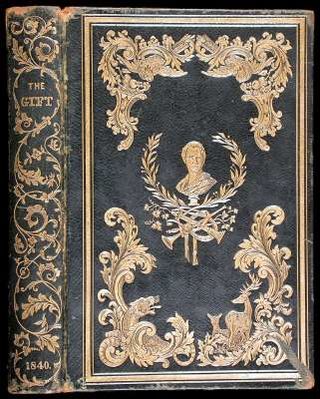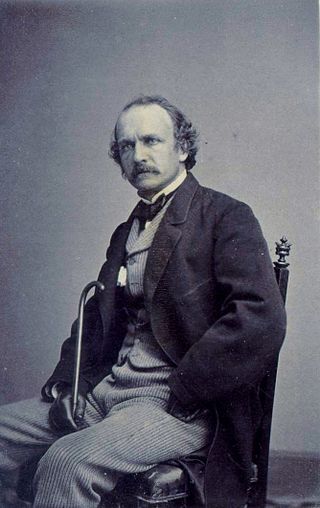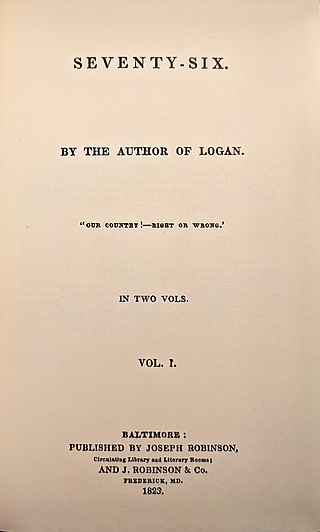Analysis of major themes
The inability of many Gothic characters to overcome perversity by rational thought is quintessential American Gothic. [1] It is not uncommon for a protagonist to be sucked into the realm of madness because of his or her inclination towards the irrational. A tendency such as this flies in the face of higher reason and seems to mock 18th-century Enlightenment thinking as outlined by Common Sense and The Age of Reason . Also, one cannot ignore the contemporary Gothic themes of mechanism and automation that rationalism and logic lead to.
Puritan imagery, particularly that of Hell, acted as potent brain candy for 19th-century authors like Edgar Allan Poe and Nathaniel Hawthorne. [2] The dark and nightmarish visions the Puritan culture of condemnation, reinforced by shame and guilt, created a lasting impact on the collective consciousness. Notions of predestination and original sin added to the doom and gloom of traditional Puritan values. This perspective and its underlying hold on American society ripened the blossoming of stories like Rachel Dyer (the first novel about the Salem witch trials), [3] "The Pit and the Pendulum", "Young Goodman Brown", and The Scarlet Letter .
The dungeons and endless corridors that are a hallmark of European Gothic are far removed from American Gothic, in which castles are replaced with caves. Lloyd-Smith reinterprets Moby-Dick to make this point convincingly. [4] Early settlers were prone to fear linked to the unexplored territory which surrounded, and in some cases, engulfed them. Fear of the unknown stemming from environmental factors like darkness and vastness is notable in Charles Brockden Brown's Edgar Huntly .
The emergence of the "ab-human" in American gothic fiction was closely coupled with the emergence of Charles Darwin's theories of evolution. [5] Ideas of evolution or devolution of a species, new biological knowledge, and technological advancement created a fertile environment for many to question their essential humanity. Parallels between humans and other living things on the planet were made obvious by the aforementioned. This is manifest in stories like H.P. Lovecraft’s "The Outsider" and Nicholson Baker's "Subsoil". Ghosts and monsters are closely related to this theme; they function as the spiritual equivalent of the abhuman and may be evocative of unseen realities, as in The Bostonians .
Julia Kristeva's concepts of jouissance and abjection are employed by American Gothic authors such as Charlotte Perkins Gilman. [6] Kristeva theorizes that the expulsion of all things defiling, much like a corpse, is a common coping mechanism for humanity. [6] Gilman's "The Yellow Wallpaper" exploits this concept. Furthermore, "The Yellow Wallpaper" can be read as a social commentary on the oppressive conditions women suffered in their home lives at the turn of the 20th century.

Edgar Allan Poe was an American writer, poet, author, editor, and literary critic who is best known for his poetry and short stories, particularly his tales of mystery and the macabre. He is widely regarded as a central figure of Romanticism and Gothic fiction in the United States, and of American literature. Poe was one of the country's earliest practitioners of the short story, and is considered the inventor of the detective fiction genre, as well as a significant contributor to the emerging genre of science fiction. He is the first well-known American writer to earn a living through writing alone, resulting in a financially difficult life and career.

Nathaniel Hawthorne was an American novelist and short story writer. His works often focus on history, morality, and religion.

Charles Brockden Brown was an American novelist, historian, and editor of the Early National period.

The Scarlet Letter: A Romance is a work of historical fiction by American author Nathaniel Hawthorne, published in 1850. Set in the Puritan Massachusetts Bay Colony during the years 1642 to 1649, the novel tells the story of Hester Prynne, who conceives a daughter with a man to whom she is not married and then struggles to create a new life of repentance and dignity. As punishment, she must wear a scarlet letter 'A'. Containing a number of religious and historic allusions, the book explores themes of legalism, sin and guilt.

"Young Goodman Brown" is a short story published in 1835 by American writer Nathaniel Hawthorne. The story takes place in 17th-century Puritan New England, a common setting for Hawthorne's works, and addresses the Calvinist/Puritan belief that all of humanity exists in a state of depravity, but that God has destined some to unconditional election through unmerited grace. Hawthorne frequently focuses on the tensions within Puritan culture, yet steeps his stories in the Puritan sense of sin. In a symbolic fashion, the story follows Young Goodman Brown's journey into self-scrutiny, which results in his loss of virtue and belief.

"William Wilson" is a short story by American writer Edgar Allan Poe, first published in 1839, with a setting inspired by Poe's formative years on the outskirts of London. The tale features a doppelgänger. It also appeared in the 1840 collection Tales of the Grotesque and Arabesque, and has been adapted several times.

"The Minister's Black Veil" is a short story written by Nathaniel Hawthorne. It was first published in the 1836 edition of The Token and Atlantic Souvenir, edited by Samuel Goodrich. It later appeared in Twice-Told Tales, a collection of short stories by Hawthorne published in 1837.

Felix Octavius Carr Darley, often credited as F. O. C. Darley, was an American illustrator, known for his illustrations in works by well-known 19th-century authors, including James Fenimore Cooper, Charles Dickens, Mary Mapes Dodge, Nathaniel Hawthorne, Washington Irving, George Lippard, Henry Wadsworth Longfellow, Donald Grant Mitchell, Clement Clarke Moore, Francis Parkman, Harriet Beecher Stowe and Nathaniel Parker Willis.

Dark Romanticism is a literary sub-genre of Romanticism, reflecting popular fascination with the irrational, the demonic and the grotesque. Often conflated with Gothic fiction, it has shadowed the euphoric Romantic movement ever since its 18th-century beginnings. Edgar Allan Poe is often celebrated as one of the supreme exponents of the tradition. Dark Romanticism focuses on human fallibility, self-destruction, judgement, punishment, as well as the psychological effects of guilt and sin.

Wieland: or, The Transformation: An American Tale, usually simply called Wieland, is the first major work by Charles Brockden Brown. First published in 1798, it distinguishes the true beginning of his career as a writer. Wieland is sometimes considered the first American Gothic novel. It has often been linked to Caleb Williams by William Godwin. Godwin's influence is clear, but Brown's writing is unique in its style. Wieland is often categorized under several subgenres other than gothic fiction, including horror, psychological fiction and epistolary fiction, which are listed at Project Gutenberg.
"Metzengerstein: A Tale in Imitation of the German" is a short story by American writer and poet Edgar Allan Poe, his first to see print. It was first published in the pages of Philadelphia's Saturday Courier magazine, in 1832. The story follows the young Frederick, the last of the Metzengerstein family, who carries on a long-standing feud with the Berlifitzing family. Suspected of causing a fire that kills the Berlifitzing family patriarch, Frederick becomes intrigued with a previously unnoticed and untamed horse. Metzengerstein is punished for his cruelty when his own home catches fire and the horse carries him into the flame. Part of a Latin hexameter by Martin Luther serves as the story's epigraph: Pestis eram vivus—moriens tua mors ero.

Radio Tales is an American series of radio drama which premiered on National Public Radio on October 29, 1996. This series adapted classic works of American and world literature such as The War of the Worlds, Twenty Thousand Leagues Under the Sea, Beowulf, Gulliver's Travels, and the One Thousand and One Nights. The series was co-produced by Winnie Waldron and Winifred Phillips. Waldron created the series and served as on-air host. Phillips composed music for the series.

American Gothic Tales is an anthology of "gothic" American short fiction. Edited and with an Introduction by Joyce Carol Oates, it was published by Plume in 1996. It featured contributions by Washington Irving, Nathaniel Hawthorne, Edgar Allan Poe, Stephen King, Anne Rice and others, and included over 40 stories.

The works of American author Edgar Allan Poe include many poems, short stories, and one novel. His fiction spans multiple genres, including horror fiction, adventure, science fiction, and detective fiction, a genre he is credited with inventing. These works are generally considered part of the Dark romanticism movement, a literary reaction to Transcendentalism. Poe's writing reflects his literary theories: he disagreed with didacticism and allegory. Meaning in literature, he said in his criticism, should be an undercurrent just beneath the surface; works whose meanings are too obvious cease to be art. Poe pursued originality in his works, and disliked proverbs. He often included elements of popular pseudosciences such as phrenology and physiognomy. His most recurring themes deal with questions of death, including its physical signs, the effects of decomposition, concerns of premature burial, the reanimation of the dead, and mourning. Though known as a masterly practitioner of Gothic fiction, Poe did not invent the genre; he was following a long-standing popular tradition.

Urban Gothic is a subgenre of Gothic fiction, film horror and television dealing with industrial and post-industrial urban society. It was pioneered in the mid-19th century in Britain, Ireland and the United States and developed in British novels such as Robert Louis Stevenson's Strange Case of Dr Jekyll and Mr Hyde (1886), and Irish novels such as Oscar Wilde's The Picture of Dorian Gray (1890), and Bram Stoker's Dracula (1897). In the twentieth century, urban Gothic influenced the creation of the subgenres of Southern Gothic and suburban Gothic. From the 1980s, interest in the urban Gothic revived with books like Anne Rice's Vampire Chronicles and a number of graphic novels that drew on dark city landscapes, leading to adaptations in film including Batman (1989), The Crow (1994) and From Hell (2001), as well as influencing films like Seven (1995).
The Mind's Eye was a publisher which produced dramatized adaptations of various written works, most notably the 1979 National Public Radio radio drama version of J.R.R. Tolkien's The Lord of the Rings and in 1980, The Hobbit. Prominent players include Bernard Mayes, Erik Bauersfeld, John Vickery, Lou Bliss, Gail Chugg, Tom Luce, Ray Reinhardt, James Arrington, Pat Franklyn, Wanda McCaddon, Rick Cimino, Joe Gostanian, John Joss, Karen Hurley, Kevin Gardiner, Darryl Ferreira, and Carl Hague. The company was acquired by Soundelux in 1992.
American Fantastic Tales is a set of two reprint horror anthologies, released as American Fantastic Tales: Terror and the Uncanny from Poe to the Pulps and American Fantastic Tales: Terror and the Uncanny from the 1940s to Now. Both anthologies were edited by Peter Straub. They were published by Library of America in 2009. The anthologies contain horror stories by American authors from the 18th century to modern times, split at 1940. The anthology pair itself won the 2010 World Fantasy Award—Anthology. The pair were also released as a boxed set in 2009.

Jeffrey Andrew Weinstock is an American literature, film, and media scholar who has been teaching in the Department of English Language and Literature at Central Michigan University since 2001. He has authored or edited twenty-nine books and a range of articles focusing on the American Gothic tradition, monsters, cult film and television, popular culture, weird fiction, pedagogy, and goth music. He is the associate editor in charge of horror for the Los Angeles Review of Books.

Seventy-Six is a historical fiction novel by American writer John Neal. Published in Baltimore in 1823, it is the fourth novel written about the American Revolutionary War. Historically distinguished for its pioneering use of colloquial language, Yankee dialect, battle scene realism, high characterization, stream of consciousness narrative, profanity, and depictions of sex and romance, the novel foreshadowed and influenced later American writers. The narrative prose resembles spoken American English more than any other literature of its period. It was the first work of American fiction to use the phrase son-of-a-bitch.

Logan, a Family History is a Gothic novel of historical fiction by American writer John Neal. Published anonymously in Baltimore in 1822, the book is loosely inspired by the true story of Mingo leader Logan the Orator, while weaving a highly fictionalized story of interactions between Anglo-American colonists and Indigenous peoples on the western frontier of colonial Virginia. Set just before the Revolutionary War, it depicts the genocide of Native Americans as the heart of the American story and follows a long cast of characters connected to each other in a complex web of overlapping love interests, family relations, rape, and sexual activity.
















